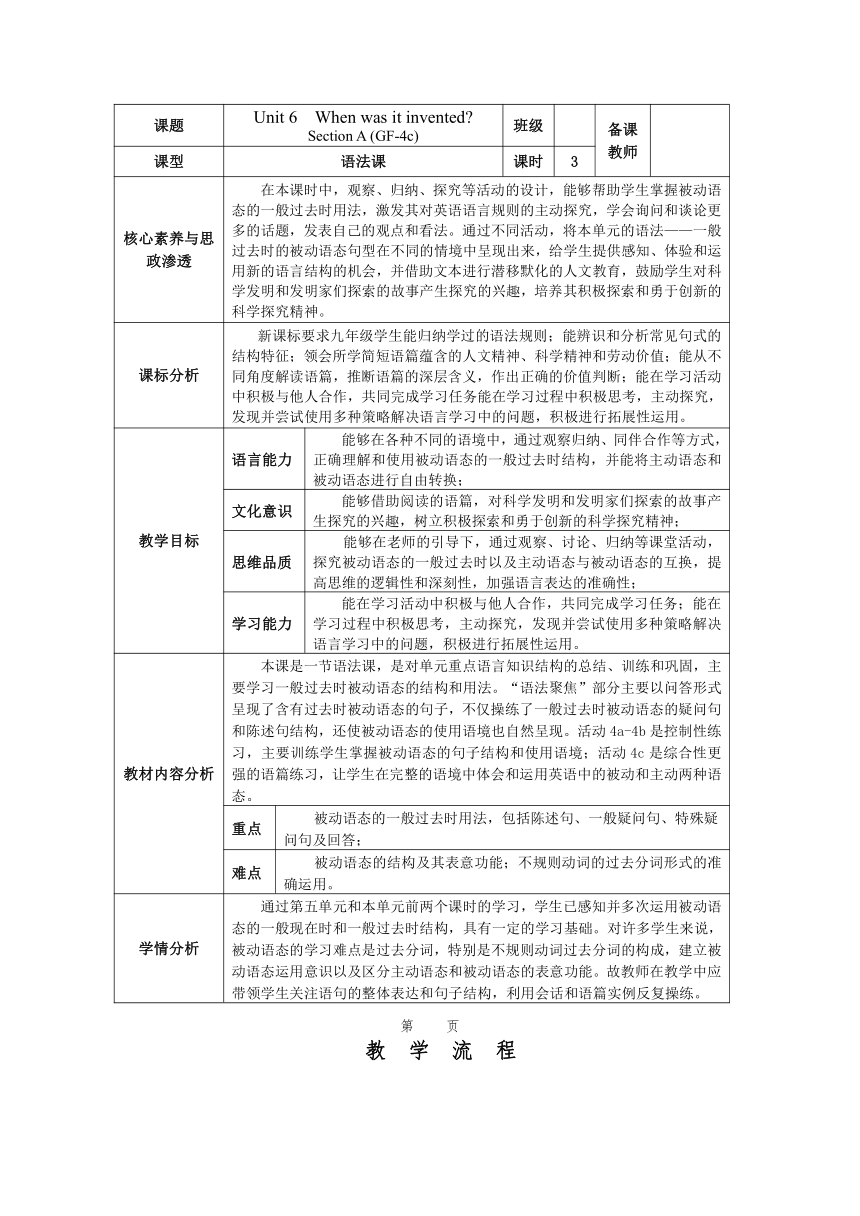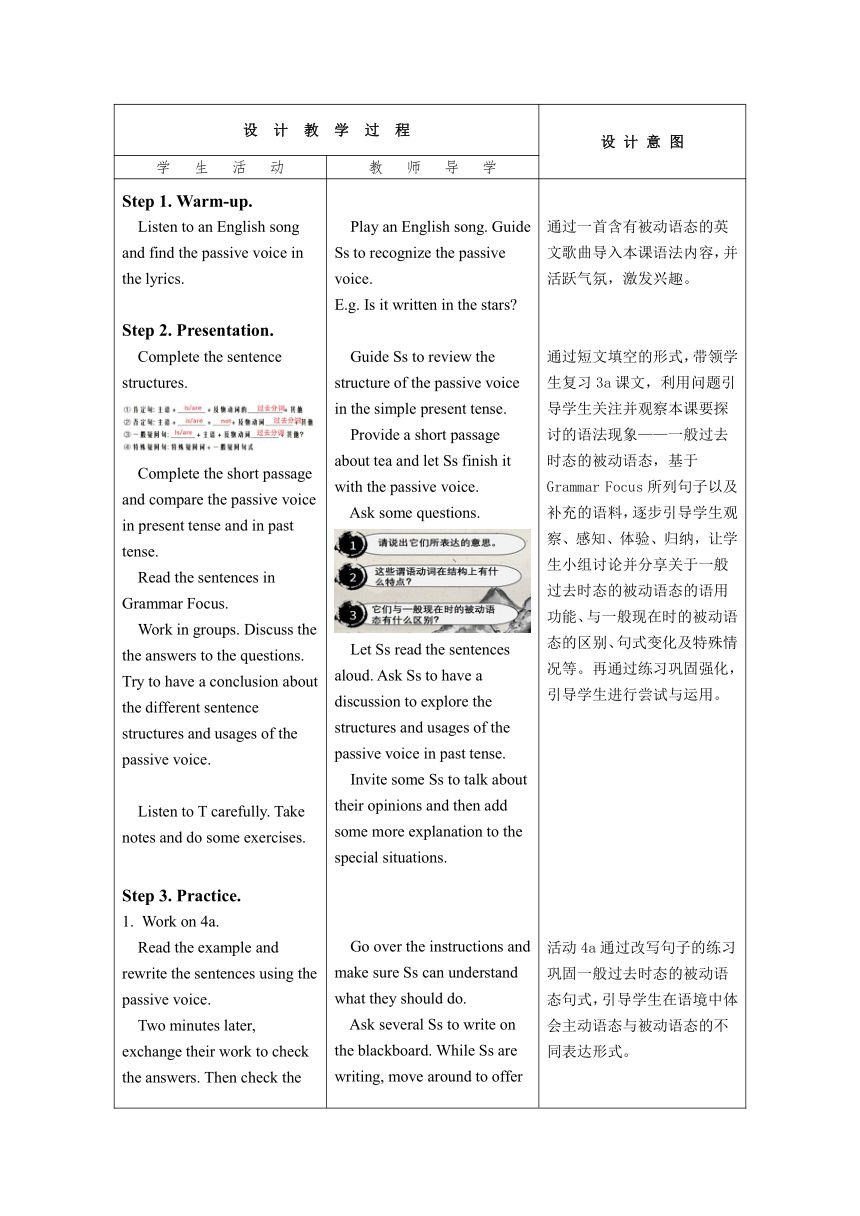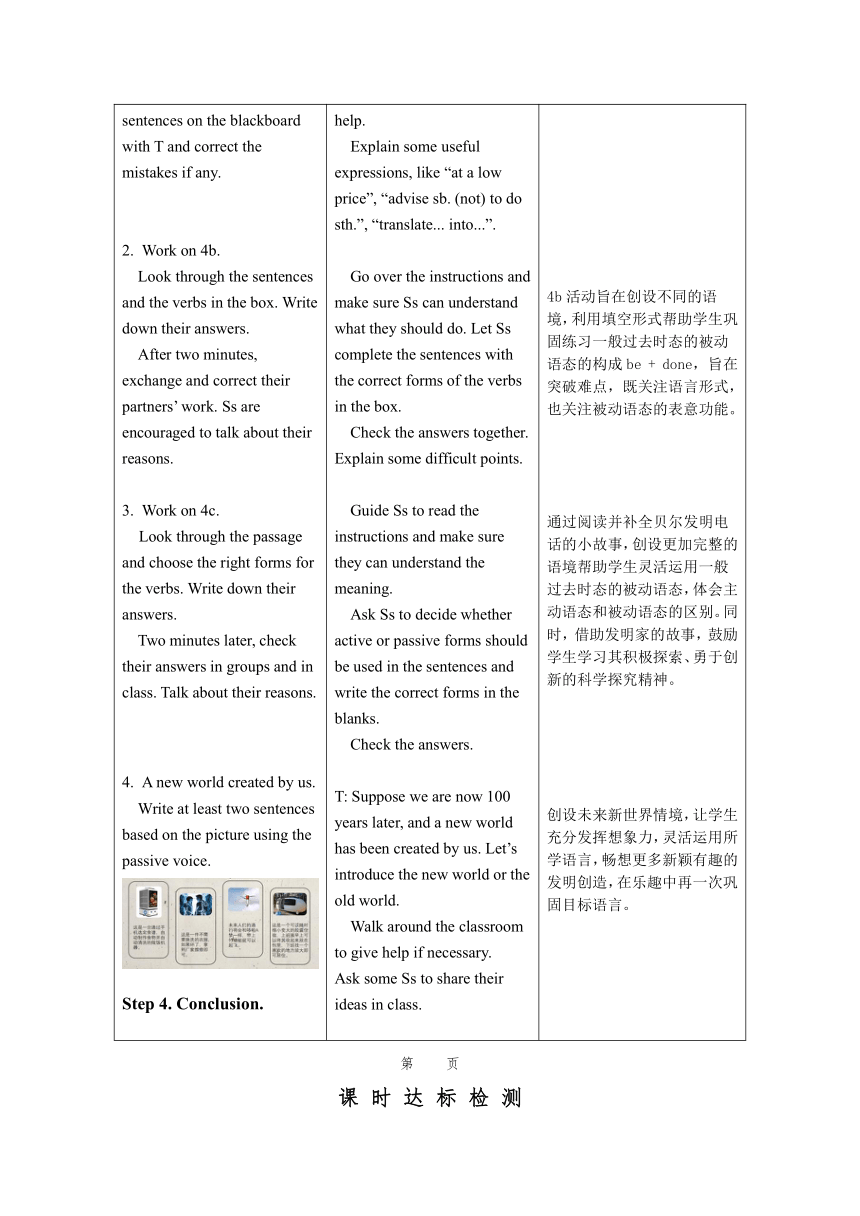【核心素养目标】Unit 6 When was it invented Section A (GF-4c)表格式教案
文档属性
| 名称 | 【核心素养目标】Unit 6 When was it invented Section A (GF-4c)表格式教案 |  | |
| 格式 | docx | ||
| 文件大小 | 770.2KB | ||
| 资源类型 | 教案 | ||
| 版本资源 | 人教新目标(Go for it)版 | ||
| 科目 | 英语 | ||
| 更新时间 | 2024-09-24 10:36:55 | ||
图片预览



文档简介
课题 Unit 6 When was it invented Section A (GF-4c) 班级 备课教师
课型 语法课 课时 3
核心素养与思政渗透 在本课时中,观察、归纳、探究等活动的设计,能够帮助学生掌握被动语态的一般过去时用法,激发其对英语语言规则的主动探究,学会询问和谈论更多的话题,发表自己的观点和看法。通过不同活动,将本单元的语法——一般过去时的被动语态句型在不同的情境中呈现出来,给学生提供感知、体验和运用新的语言结构的机会,并借助文本进行潜移默化的人文教育,鼓励学生对科学发明和发明家们探索的故事产生探究的兴趣,培养其积极探索和勇于创新的科学探究精神。
课标分析 新课标要求九年级学生能归纳学过的语法规则;能辨识和分析常见句式的结构特征;领会所学简短语篇蕴含的人文精神、科学精神和劳动价值;能从不同角度解读语篇,推断语篇的深层含义,作出正确的价值判断;能在学习活动中积极与他人合作,共同完成学习任务能在学习过程中积极思考,主动探究,发现并尝试使用多种策略解决语言学习中的问题,积极进行拓展性运用。
教学目标 语言能力 能够在各种不同的语境中,通过观察归纳、同伴合作等方式,正确理解和使用被动语态的一般过去时结构,并能将主动语态和被动语态进行自由转换;
文化意识 能够借助阅读的语篇,对科学发明和发明家们探索的故事产生探究的兴趣,树立积极探索和勇于创新的科学探究精神;
思维品质 能够在老师的引导下,通过观察、讨论、归纳等课堂活动,探究被动语态的一般过去时以及主动语态与被动语态的互换,提高思维的逻辑性和深刻性,加强语言表达的准确性;
学习能力 能在学习活动中积极与他人合作,共同完成学习任务;能在学习过程中积极思考,主动探究,发现并尝试使用多种策略解决语言学习中的问题,积极进行拓展性运用。
教材内容分析 本课是一节语法课,是对单元重点语言知识结构的总结、训练和巩固,主要学习一般过去时被动语态的结构和用法。“语法聚焦”部分主要以问答形式呈现了含有过去时被动语态的句子,不仅操练了一般过去时被动语态的疑问句和陈述句结构,还使被动语态的使用语境也自然呈现。活动4a-4b是控制性练习,主要训练学生掌握被动语态的句子结构和使用语境;活动4c是综合性更强的语篇练习,让学生在完整的语境中体会和运用英语中的被动和主动两种语态。
重点 被动语态的一般过去时用法,包括陈述句、一般疑问句、特殊疑问句及回答;
难点 被动语态的结构及其表意功能;不规则动词的过去分词形式的准确运用。
学情分析 通过第五单元和本单元前两个课时的学习,学生已感知并多次运用被动语态的一般现在时和一般过去时结构,具有一定的学习基础。对许多学生来说,被动语态的学习难点是过去分词,特别是不规则动词过去分词的构成,建立被动语态运用意识以及区分主动语态和被动语态的表意功能。故教师在教学中应带领学生关注语句的整体表达和句子结构,利用会话和语篇实例反复操练。
第 页
教 学 流 程
设 计 教 学 过 程 设 计 意 图
学 生 活 动 教 师 导 学
Step 1. Warm-up. Listen to an English song and find the passive voice in the lyrics. Step 2. Presentation. Complete the sentence plete the short passage and compare the passive voice in present tense and in past tense. Read the sentences in Grammar Focus. Work in groups. Discuss the the answers to the questions. Try to have a conclusion about the different sentence structures and usages of the passive voice. Listen to T carefully. Take notes and do some exercises. Step 3. Practice. Work on 4a. Read the example and rewrite the sentences using the passive voice. Two minutes later, exchange their work to check the answers. Then check the sentences on the blackboard with T and correct the mistakes if any. Work on 4b. Look through the sentences and the verbs in the box. Write down their answers. After two minutes, exchange and correct their partners’ work. Ss are encouraged to talk about their reasons. Work on 4c. Look through the passage and choose the right forms for the verbs. Write down their answers. Two minutes later, check their answers in groups and in class. Talk about their reasons. A new world created by us. Write at least two sentences based on the picture using the passive voice. Step 4. Conclusion. Play an English song. Guide Ss to recognize the passive voice. E.g. Is it written in the stars Guide Ss to review the structure of the passive voice in the simple present tense. Provide a short passage about tea and let Ss finish it with the passive voice. Ask some questions. Let Ss read the sentences aloud. Ask Ss to have a discussion to explore the structures and usages of the passive voice in past tense. Invite some Ss to talk about their opinions and then add some more explanation to the special situations. Go over the instructions and make sure Ss can understand what they should do. Ask several Ss to write on the blackboard. While Ss are writing, move around to offer help. Explain some useful expressions, like “at a low price”, “advise sb. (not) to do sth.”, “translate... into...”. Go over the instructions and make sure Ss can understand what they should do. Let Ss complete the sentences with the correct forms of the verbs in the box. Check the answers together. Explain some difficult points. Guide Ss to read the instructions and make sure they can understand the meaning. Ask Ss to decide whether active or passive forms should be used in the sentences and write the correct forms in the blanks. Check the answers. T: Suppose we are now 100 years later, and a new world has been created by us. Let’s introduce the new world or the old world. Walk around the classroom to give help if necessary. Ask some Ss to share their ideas in class. 通过一首含有被动语态的英文歌曲导入本课语法内容,并活跃气氛,激发兴趣。 通过短文填空的形式,带领学生复习3a课文,利用问题引导学生关注并观察本课要探讨的语法现象——一般过去时态的被动语态,基于Grammar Focus所列句子以及补充的语料,逐步引导学生观察、感知、体验、归纳,让学生小组讨论并分享关于一般过去时态的被动语态的语用功能、与一般现在时的被动语态的区别、句式变化及特殊情况等。再通过练习巩固强化,引导学生进行尝试与运用。 活动4a通过改写句子的练习巩固一般过去时态的被动语态句式,引导学生在语境中体会主动语态与被动语态的不同表达形式。 4b活动旨在创设不同的语境,利用填空形式帮助学生巩固练习一般过去时态的被动语态的构成be + done,旨在突破难点,既关注语言形式,也关注被动语态的表意功能。 通过阅读并补全贝尔发明电话的小故事,创设更加完整的语境帮助学生灵活运用一般过去时态的被动语态,体会主动语态和被动语态的区别。同时,借助发明家的故事,鼓励学生学习其积极探索、勇于创新的科学探究精神。 创设未来新世界情境,让学生充分发挥想象力,灵活运用所学语言,畅想更多新颖有趣的发明创造,在乐趣中再一次巩固目标语言。
第 页
课 时 达 标 检 测
一.选择题 ( )1. A new school _______ last year in my hometown. A. set up B. sets up C. is set up D. was set up ( )2. These model cars ____ in China in 2018. A. are made B. were made C. make D. made ( )3. Last March, many trees ______ along the streets to make our city more beautiful. A. were planted B. were planting C. had planted D. planted ( )4. To my great surprise, the famous athlete's story ____differently in the newspaper. A. was reported B. reported C. was reporting D. reports ( )5. He Jiang _________ to give a speech at the graduation ceremony at Harvard University last month. A. invites B. invited C. is invited D. was invited 二.填空题 6. Which language ___the most widely ________ (speak) in the world? 7. Last year a large number of trees___________(cut) down. 8. The students _____ often _____ (tell) to take care of their desks and chairs. 9. Vegetables, eggs and fruits____________ (sell) in this shop. 10. What _______ knives ______ (make) of 11. The room _____________ (clean) by me every day. 12. The stars ______________ (not see) last night. 13. Your pen __________ (write) quite smoothly.
第 页
课 时 教 学 设 计 尾 页
板 书 设 计
Unit 6 When was it invented Section A (GF-4c)
作 业 设 计
Level A Search for more interesting stories about inventors and inventions. Write one of them in English on your own. Try to use passive voice.
Level B Do more exercises of the passive voice.
教 学 反 思
第 页
课型 语法课 课时 3
核心素养与思政渗透 在本课时中,观察、归纳、探究等活动的设计,能够帮助学生掌握被动语态的一般过去时用法,激发其对英语语言规则的主动探究,学会询问和谈论更多的话题,发表自己的观点和看法。通过不同活动,将本单元的语法——一般过去时的被动语态句型在不同的情境中呈现出来,给学生提供感知、体验和运用新的语言结构的机会,并借助文本进行潜移默化的人文教育,鼓励学生对科学发明和发明家们探索的故事产生探究的兴趣,培养其积极探索和勇于创新的科学探究精神。
课标分析 新课标要求九年级学生能归纳学过的语法规则;能辨识和分析常见句式的结构特征;领会所学简短语篇蕴含的人文精神、科学精神和劳动价值;能从不同角度解读语篇,推断语篇的深层含义,作出正确的价值判断;能在学习活动中积极与他人合作,共同完成学习任务能在学习过程中积极思考,主动探究,发现并尝试使用多种策略解决语言学习中的问题,积极进行拓展性运用。
教学目标 语言能力 能够在各种不同的语境中,通过观察归纳、同伴合作等方式,正确理解和使用被动语态的一般过去时结构,并能将主动语态和被动语态进行自由转换;
文化意识 能够借助阅读的语篇,对科学发明和发明家们探索的故事产生探究的兴趣,树立积极探索和勇于创新的科学探究精神;
思维品质 能够在老师的引导下,通过观察、讨论、归纳等课堂活动,探究被动语态的一般过去时以及主动语态与被动语态的互换,提高思维的逻辑性和深刻性,加强语言表达的准确性;
学习能力 能在学习活动中积极与他人合作,共同完成学习任务;能在学习过程中积极思考,主动探究,发现并尝试使用多种策略解决语言学习中的问题,积极进行拓展性运用。
教材内容分析 本课是一节语法课,是对单元重点语言知识结构的总结、训练和巩固,主要学习一般过去时被动语态的结构和用法。“语法聚焦”部分主要以问答形式呈现了含有过去时被动语态的句子,不仅操练了一般过去时被动语态的疑问句和陈述句结构,还使被动语态的使用语境也自然呈现。活动4a-4b是控制性练习,主要训练学生掌握被动语态的句子结构和使用语境;活动4c是综合性更强的语篇练习,让学生在完整的语境中体会和运用英语中的被动和主动两种语态。
重点 被动语态的一般过去时用法,包括陈述句、一般疑问句、特殊疑问句及回答;
难点 被动语态的结构及其表意功能;不规则动词的过去分词形式的准确运用。
学情分析 通过第五单元和本单元前两个课时的学习,学生已感知并多次运用被动语态的一般现在时和一般过去时结构,具有一定的学习基础。对许多学生来说,被动语态的学习难点是过去分词,特别是不规则动词过去分词的构成,建立被动语态运用意识以及区分主动语态和被动语态的表意功能。故教师在教学中应带领学生关注语句的整体表达和句子结构,利用会话和语篇实例反复操练。
第 页
教 学 流 程
设 计 教 学 过 程 设 计 意 图
学 生 活 动 教 师 导 学
Step 1. Warm-up. Listen to an English song and find the passive voice in the lyrics. Step 2. Presentation. Complete the sentence plete the short passage and compare the passive voice in present tense and in past tense. Read the sentences in Grammar Focus. Work in groups. Discuss the the answers to the questions. Try to have a conclusion about the different sentence structures and usages of the passive voice. Listen to T carefully. Take notes and do some exercises. Step 3. Practice. Work on 4a. Read the example and rewrite the sentences using the passive voice. Two minutes later, exchange their work to check the answers. Then check the sentences on the blackboard with T and correct the mistakes if any. Work on 4b. Look through the sentences and the verbs in the box. Write down their answers. After two minutes, exchange and correct their partners’ work. Ss are encouraged to talk about their reasons. Work on 4c. Look through the passage and choose the right forms for the verbs. Write down their answers. Two minutes later, check their answers in groups and in class. Talk about their reasons. A new world created by us. Write at least two sentences based on the picture using the passive voice. Step 4. Conclusion. Play an English song. Guide Ss to recognize the passive voice. E.g. Is it written in the stars Guide Ss to review the structure of the passive voice in the simple present tense. Provide a short passage about tea and let Ss finish it with the passive voice. Ask some questions. Let Ss read the sentences aloud. Ask Ss to have a discussion to explore the structures and usages of the passive voice in past tense. Invite some Ss to talk about their opinions and then add some more explanation to the special situations. Go over the instructions and make sure Ss can understand what they should do. Ask several Ss to write on the blackboard. While Ss are writing, move around to offer help. Explain some useful expressions, like “at a low price”, “advise sb. (not) to do sth.”, “translate... into...”. Go over the instructions and make sure Ss can understand what they should do. Let Ss complete the sentences with the correct forms of the verbs in the box. Check the answers together. Explain some difficult points. Guide Ss to read the instructions and make sure they can understand the meaning. Ask Ss to decide whether active or passive forms should be used in the sentences and write the correct forms in the blanks. Check the answers. T: Suppose we are now 100 years later, and a new world has been created by us. Let’s introduce the new world or the old world. Walk around the classroom to give help if necessary. Ask some Ss to share their ideas in class. 通过一首含有被动语态的英文歌曲导入本课语法内容,并活跃气氛,激发兴趣。 通过短文填空的形式,带领学生复习3a课文,利用问题引导学生关注并观察本课要探讨的语法现象——一般过去时态的被动语态,基于Grammar Focus所列句子以及补充的语料,逐步引导学生观察、感知、体验、归纳,让学生小组讨论并分享关于一般过去时态的被动语态的语用功能、与一般现在时的被动语态的区别、句式变化及特殊情况等。再通过练习巩固强化,引导学生进行尝试与运用。 活动4a通过改写句子的练习巩固一般过去时态的被动语态句式,引导学生在语境中体会主动语态与被动语态的不同表达形式。 4b活动旨在创设不同的语境,利用填空形式帮助学生巩固练习一般过去时态的被动语态的构成be + done,旨在突破难点,既关注语言形式,也关注被动语态的表意功能。 通过阅读并补全贝尔发明电话的小故事,创设更加完整的语境帮助学生灵活运用一般过去时态的被动语态,体会主动语态和被动语态的区别。同时,借助发明家的故事,鼓励学生学习其积极探索、勇于创新的科学探究精神。 创设未来新世界情境,让学生充分发挥想象力,灵活运用所学语言,畅想更多新颖有趣的发明创造,在乐趣中再一次巩固目标语言。
第 页
课 时 达 标 检 测
一.选择题 ( )1. A new school _______ last year in my hometown. A. set up B. sets up C. is set up D. was set up ( )2. These model cars ____ in China in 2018. A. are made B. were made C. make D. made ( )3. Last March, many trees ______ along the streets to make our city more beautiful. A. were planted B. were planting C. had planted D. planted ( )4. To my great surprise, the famous athlete's story ____differently in the newspaper. A. was reported B. reported C. was reporting D. reports ( )5. He Jiang _________ to give a speech at the graduation ceremony at Harvard University last month. A. invites B. invited C. is invited D. was invited 二.填空题 6. Which language ___the most widely ________ (speak) in the world? 7. Last year a large number of trees___________(cut) down. 8. The students _____ often _____ (tell) to take care of their desks and chairs. 9. Vegetables, eggs and fruits____________ (sell) in this shop. 10. What _______ knives ______ (make) of 11. The room _____________ (clean) by me every day. 12. The stars ______________ (not see) last night. 13. Your pen __________ (write) quite smoothly.
第 页
课 时 教 学 设 计 尾 页
板 书 设 计
Unit 6 When was it invented Section A (GF-4c)
作 业 设 计
Level A Search for more interesting stories about inventors and inventions. Write one of them in English on your own. Try to use passive voice.
Level B Do more exercises of the passive voice.
教 学 反 思
第 页
同课章节目录
- Unit 1 How can we become good learners.
- Section A
- Section B
- Unit 2 I think that mooncakes are delicious!
- Section A
- Section B
- Unit 3 Could you please tell me where the restroom
- Section A
- Section B
- Unit 4 I used to be afraid of the dark.
- Section A
- Section B
- Unit 5 What are the shirts made of?
- Section A
- Section B
- Review of Units 1-5
- Unit 6 When was it invented?
- Section A
- Section B
- Unit 7 Teenagers should be allowed to choose their
- Section A
- Section B
- Unit 8 It must belong to Carla.
- Section A
- Section B
- Unit 9 I like music that I can dance to.
- Section A
- Section B
- Unit 10 You're supposed to shake hands.
- Section A
- Section B
- Review of Units 6-10
- Unit 11 Sad movies make me cry.
- Section A
- Section B
- Unit 12 Life is full of the unexpected
- Section A
- Section B
- Unit 13 We're trying to save the earth!
- Section A
- Section B
- Unit 14 I remember meeting all of you in Grade 7.
- Section A
- Section B
- Review of Units 11-14
